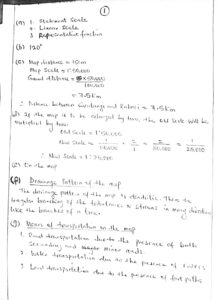
*NABTEB GCE 2024 GEOGRAPHY PRACTICAL ANSWERS*
_SECTION A_
(1)

=======================================
_SECTION B_
*PART I; ANSWER TWO(2) QUESTIONS FROM THIS PART*
(2ai)
Dissected Plateau:
A dissected plateau forms when a plateau, which is initially flat or slightly elevated, undergoes extensive erosion over time. This erosion is typically caused by rivers, wind, and other weathering agents that cut through the plateau, creating valleys and ridges. The resulting landscape has steep valleys and hills, giving it a rugged and uneven appearance. Dissected plateaus are often found in areas where tectonic uplift has raised a portion of the Earth’s crust, followed by prolonged erosion, which carves the plateau into a complex terrain.
(2aii)
Erosional Plain:
An erosional plain is created when a highland or mountainous area is gradually worn down by erosion processes such as wind, water, and glacial activity. Over millions of years, these agents wear down the surface, smoothing it out and lowering it to near sea level. Eventually, the landscape becomes a flat or gently rolling plain. Erosional plains are often found in areas that have been tectonically stable, allowing erosion to work for a long period without significant uplift.
(2b)
=ADVANTAGES OF LOWLANDS=
(i) Fertile soil: Lowlands often have rich, fertile soil for agriculture.
(ii) Accessibility: Low-lying areas facilitate transportation and trade.
=DISADVANTAGES OF LOWLANDS=
(i) Flooding risk: Lowlands are prone to flooding due to proximity to water sources.
(ii) Limited development: Low-lying areas may be unsuitable for construction due to waterlogging or instability.
=======================================
(3a)
(i) Latitude: This determines how much solar energy a place receives. Areas closer to the equator experience higher temperatures due to more direct sunlight, while places near the poles receive less sunlight and are generally cooler.
(ii) Altitude: Higher altitudes typically have cooler temperatures due to lower air pressure and thinner atmosphere, which holds less heat. As you go up in elevation, the temperature generally decreases.
(iii) Proximity to Water Bodies: Large bodies of water, like oceans and lakes, moderate the climate of nearby areas. Water heats and cools more slowly than land, leading to milder temperatures in coastal regions.
(iv) Wind and Ocean Currents: Winds and ocean currents distribute heat around the Earth. Warm ocean currents raise the temperature of nearby coastal areas, while cold currents can have a cooling effect. Similarly, winds carry air masses with specific temperature and humidity characteristics, affecting regional weather.
(3b)
(i) Thermometer:
A thermometer is used to measure temperature. It contains a liquid (usually mercury or alcohol) that expands and rises in a glass tube as the temperature increases and contracts when it decreases. The level of the liquid corresponds to temperature readings on a calibrated scale, allowing meteorologists to measure daily or seasonal temperature variations.
(ii) Rain Gauge:
A rain gauge is used to measure the amount of rainfall. It typically consists of a cylindrical container that collects rainwater. The collected water is then measured using a graduated scale, often in millimeters, to determine the amount of precipitation that has fallen over a specific period. This helps monitor and analyze rainfall patterns in different areas.
=======================================
(4ai)
Granite:
(i) Coarse-grained, with visible crystals of minerals such as quartz, feldspar, and mica.
(ii) Usually light-colored, commonly found in shades of pink, white, gray, or light brown.
(iii) Very hard and durable due to its high silica content.
(iv) Composed mainly of quartz, feldspar, and mica, giving it a rich silica content.
(4aii)
Limestone:
(i) Fine to coarse-grained, depending on the size of calcite crystals or fossils it contains.
(ii) Typically white, gray, or cream, though can have other colors due to impurities.
(iii) Primarily made of calcium carbonate (calcite), often with fossilized remains of marine organisms.
(iv) Reacts with hydrochloric acid, releasing carbon dioxide.
(4aiii)
Graphite:
(i) Soft and greasy to the touch, with a slippery feel.
(ii) Dark gray to black.
(iii) Very soft, with a hardness of 1-2 on the Mohs scale.
(iv) Made entirely of carbon atoms arranged in layers.
(4b)
Igneous rocks form from the cooling and solidification of molten rock material called magma (beneath the Earth’s surface) or lava (at or near the Earth’s surface). The mode of formation depends on where the cooling process takes place:
(i) Intrusive (Plutonic) Igneous Rocks: These rocks form when magma cools slowly beneath the Earth’s surface. The slow cooling allows large crystals to form, resulting in coarse-grained textures, as seen in granite.
(ii) Extrusive (Volcanic) Igneous Rocks: These rocks form when lava erupts onto the Earth’s surface and cools quickly. Rapid cooling leads to the formation of small crystals or a fine-grained texture, as seen in basalt.
=======================================
*PART II; ANSWER ONE(1) QUESTIONS FROM THIS PART*
(5a)
(i) Urban Planning and Development
(ii) Environmental Management
(iii) Disaster Management and Emergency Response
(5b)
(i) Urban Planning and Development:
GIS is essential in urban planning for tasks like zoning, land-use planning, and infrastructure development. It helps planners visualize and analyze spatial data to make decisions about road networks, housing developments, and utility distribution. With GIS, planners can simulate different development scenarios, predict future growth, and identify potential problem areas to improve decision-making and resource allocation.
(ii) Environmental Management:
In environmental management, GIS is used to monitor natural resources, assess environmental impacts, and manage conservation efforts. GIS tools enable the analysis of changes in land cover, forest health, water bodies, and biodiversity. For example, GIS can track deforestation, pollution spread, and habitat loss, helping environmental agencies make informed decisions for sustainability and conservation efforts.
(5c)
(i) Data Availability and Quality: Limited access to accurate, up-to-date spatial data hinders effective GIS application.
(ii) Infrastructure and Technical Capacity: Inadequate computing resources, software, and skilled personnel restrict GIS adoption.
(iii) Funding and Institutional Support: Insufficient financial resources and lack of government backing limit GIS implementation and maintenance.
=======================================
(6ai)
(i) Land Use and Land Cover: Monitoring urban growth, deforestation, agriculture, and other land changes.
(ii) Weather and Climate Patterns: Tracking weather conditions, climate changes, storm formations, and temperature variations.
(iii) Water Bodies and Hydrology: Observing water quality, sediment levels, flood monitoring, and ocean currents.
(iv) Vegetation and Agriculture: Assessing crop health, vegetation density, drought stress, and plant species distribution.
(6bii)
(i) Data Collection: Gathering data through sensors on satellites or airborne platforms that capture images and other types of electromagnetic radiation.
(ii) Data Analysis and Interpretation: Processing and analyzing the collected data to interpret patterns, changes, or conditions of the observed area.
(6b)
(i) Large Area Coverage: Allows for the observation of vast and remote areas that may be hard to access on the ground.
(ii) Consistent and Repeated Observations: Enables continuous monitoring of changes over time, useful for tracking trends and developments.
(iii) Multispectral Imaging Capability: Collects data across different wavelengths, helping differentiate materials, vegetation types, and environmental conditions.
(iv) Time and Cost Efficiency: Reduces the need for costly and time-consuming on-site surveys, enabling faster data acquisition and analysis.
=======================================
COMPLETED

Leave a Reply